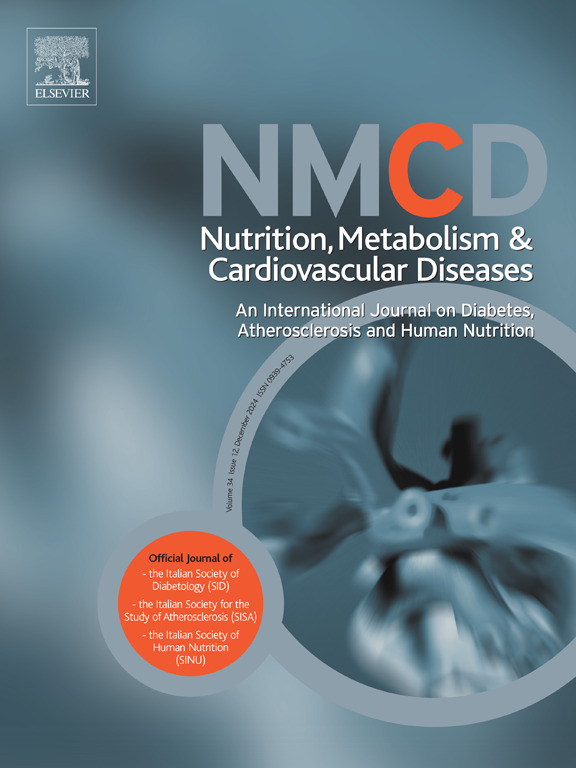Sedentary lifestyle and physical inactivity: A mutual interplay with early and overt frailty
IF 3.3
3区 医学
Q2 CARDIAC & CARDIOVASCULAR SYSTEMS
Nutrition Metabolism and Cardiovascular Diseases
Pub Date : 2025-03-12
DOI:10.1016/j.numecd.2025.103971
引用次数: 0
Abstract
Aims
In recent years medical science and research are increasingly directed towards a holistic approach that considers health as global well-being rather than solely as the absence of disease. In this framework, lifestyle interventions and, in particular, physical exercise, are of crucial importance in prevention and treatment. Therefore, the purpose of this study is to describe this mutual interplay between physical behaviours, sarcopenia, and frailty, as well as to illustrate the role of structured exercise training in aging and disease.
Data synthesis
Physical activity and exercise training are determinants of lifelong global wellness and healthy aging. On the contrary, sedentary behaviour and physical inactivity are strictly linked to frailty and pre-frailty, both in adults and the elderly, with or without chronic diseases. On the other hand, the presence of pathological conditions is associated with a more inactive and sedentary behaviour. The co-presence of these factors is characterized by a mutual causal exchange in which they are imbricated in a continuous mechanistic interplay that involves inflammation, sarcopenia, osteopenia, functional impairment and many other pathophysiological aspects that rapidly can lead to a status of frailty.
Conclusion
A sedentary lifestyle and physical inactivity critically affect alterations in body composition and loss in functional capacity, typically linked to aging and accelerated by chronic diseases. However, physical activity and exercise can counteract the onset of pre-frailty and frailty by conferring beneficial effects on the individual's overall well-being.
久坐的生活方式和缺乏运动:与早期和明显的虚弱相互影响。
目的:近年来,医学科学和研究越来越倾向于采用一种全面的方法,将健康视为全球福祉,而不仅仅是没有疾病。在这一框架下,生活方式干预,尤其是体育锻炼,在预防和治疗中至关重要。因此,本研究旨在描述体育行为、肌肉疏松症和虚弱之间的相互影响,并说明结构化运动训练在衰老和疾病中的作用:数据综述:体育活动和运动训练是终身全面健康和健康老龄化的决定因素。相反,无论是否患有慢性疾病,久坐不动和缺乏运动都与成年人和老年人的虚弱和虚弱前期密切相关。另一方面,病理状况的存在与更不活跃和久坐不动的行为有关。这些因素共同存在的特点是相互之间的因果交换,它们交织在一个持续的机制相互作用中,涉及炎症、肌肉疏松症、骨质疏松症、功能障碍和许多其他病理生理方面,可迅速导致虚弱状态:结论:久坐不动的生活方式和缺乏运动会严重影响身体成分的改变和功能的丧失,这通常与衰老有关,并因慢性疾病而加速。然而,体力活动和锻炼可以抵消虚弱前期和虚弱期的出现,对个人的整体健康产生有益的影响。
本文章由计算机程序翻译,如有差异,请以英文原文为准。
求助全文
约1分钟内获得全文
求助全文
来源期刊
CiteScore
6.80
自引率
2.60%
发文量
332
审稿时长
57 days
期刊介绍:
Nutrition, Metabolism & Cardiovascular Diseases is a forum designed to focus on the powerful interplay between nutritional and metabolic alterations, and cardiovascular disorders. It aims to be a highly qualified tool to help refine strategies against the nutrition-related epidemics of metabolic and cardiovascular diseases. By presenting original clinical and experimental findings, it introduces readers and authors into a rapidly developing area of clinical and preventive medicine, including also vascular biology. Of particular concern are the origins, the mechanisms and the means to prevent and control diabetes, atherosclerosis, hypertension, and other nutrition-related diseases.

 求助内容:
求助内容: 应助结果提醒方式:
应助结果提醒方式:


